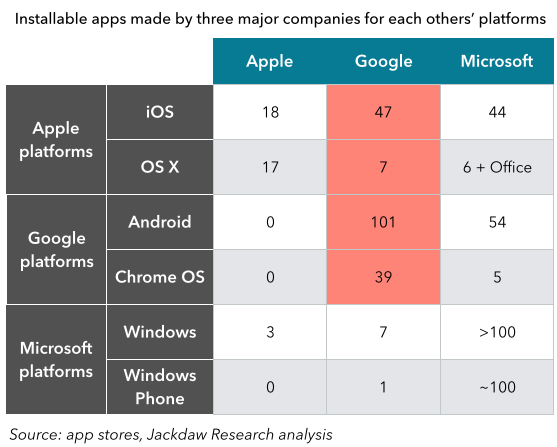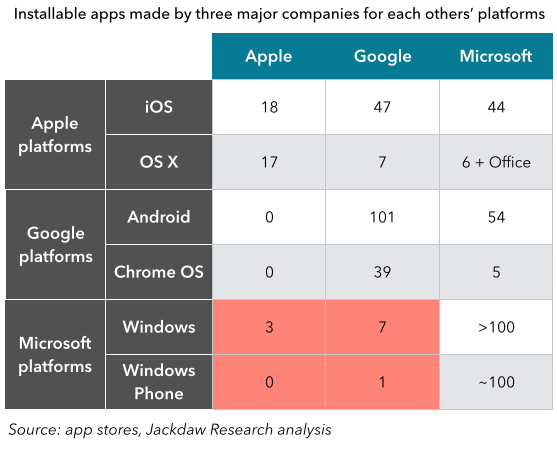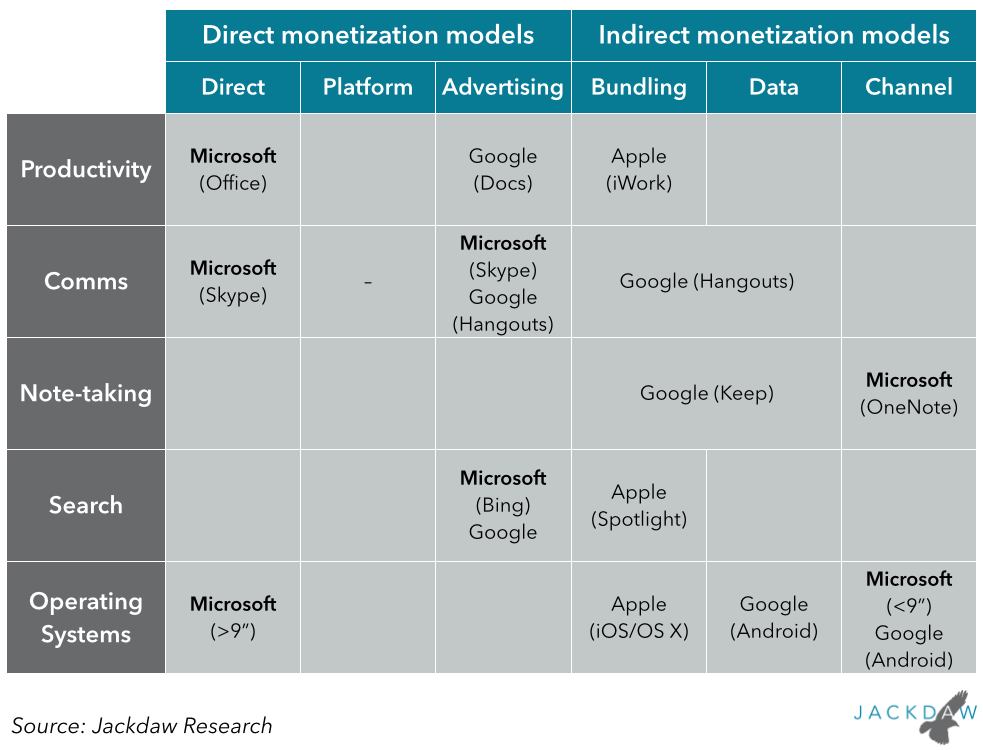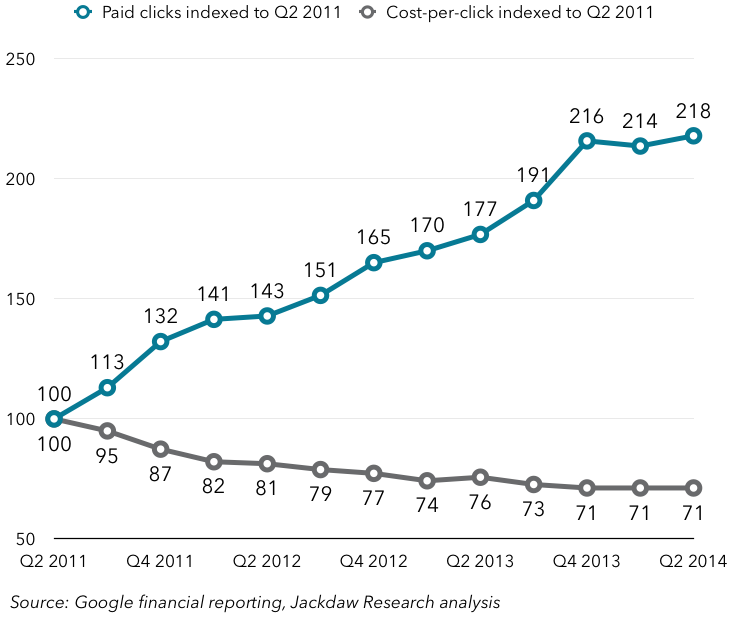This is a post I had intended to write a few weeks back, when the Google MVNO rumors first started circulating, but never got around to. With Sundar Pichai’s remarks at Mobile World Congress this week rekindling the topic, I thought I’d finally set down by thoughts on this story. I haven’t been completely silent on this topic – I’ve tweeted about it quite a bit, talked to a few reporters, and discussed it on the Techpinions podcast (skip to 21:35). But I wanted to pull my thoughts together here in a coherent fashion. I’m pasting a transcript of my remarks on the podcast at the bottom of this post, because it sums this up pretty neatly, but I’ll expand a bit on the detail here.
The two rules of MVNOs
If you don’t know much about MVNOs, I’ll give you a quick primer. The first thing to know is that an MVNO is a mobile virtual network operator, which means these companies don’t own their own networks, but instead buy “airtime” (minutes, data etc) on a wholesale basis from those who do. In some markets such wholesale arrangements are mandated and regulated, but in others (including the US), both the arrangements themselves and the pricing are left to individual operators.
All this gives rise to what I like to think of as the two rules of MVNOs:
- You can never be truly disruptive to the company whose network you’re using, because it always has the power to shut your business down
- Wireless carriers will never support you as an MVNO unless they believe you can reach a niche or segment they can’t reach as effectively directly, rather than competing directly with them.
Partly as a result of these rules, despite the success of MVNOs in certain other markets, they’ve largely failed in the US, with many going out of business or being acquired by their host network operators. The one exception is Tracfone, which uses several major operators’ networks and targets largely low-end prepaid subscribers most of the carriers don’t want to own directly.
What this means for Google
All of which brings us to Google’s reported ambitions in the MVNO space, which are allegedly based on some sort of cooperation with T-Mobile and Sprint. In addition to the two rules above, the third thing worth bearing in mind here is most carriers’ view of Google. Google is one of the two companies that already has the most leverage over the carriers today, along with Apple. While Apple has arguably been more disruptive to most carriers with its refusal to pre-install carrier software, its direct retail and customer service relationships with many customers, its FaceTime and iMessage offerings which compete with carrier voice and text messaging and so on, Google has already demonstrated that it’s perfectly willing to disrupt carriers’ businesses too. Google Fiber, Hangouts, Google Voice, Google Wallet, Android Pay, Google Maps and other products either have already disrupted or have the potential to disrupt services offered by carriers. With both Apple and Google, carriers are already looking for ways to reduce their dependence on them and to temper their influence and power with end users.
Taking the two MVNO rules and these opinions about Google together, then, we can easily see that whatever Google wanted to do in mobile, the carriers wouldn’t support it unless it:
- Would be complementary to their businesses
- Would be relatively small in scale
- Would not compete directly in any meaningful way with their existing offerings
- Would not compete directly on price.
Three possible business models
Given all this, ideas about full-blown wireless services from Google make little sense. What makes much more sense is something that’s narrowly defined, targeted and relatively small in the grand scheme of things. Three possibilities I’ve floated are:
- Wireless connectivity for Nexus devices, the only wireless devices Google sells directly to consumers through the Play store, such that this connectivity would be built in with the purchase, and the customer would only ever deal with Google. This would overcome some of Google’s challenges with getting carriers to carry Nexus devices directly, and fits with the new direction Google is taking with Nexus devices, moving away from the developer focus and towards a broader consumer appeal
- Wireless connectivity for non-phone devices, such as a successor to the Chromebook Pixel, Android tablets (perhaps Nexus ones only, in keeping with the previous bullet), etc. This could potentially also include Android Wear devices with their own cellular connectivity.
- Wireless connectivity for smart home, connected car or other non-device applications. With Google’s Nest business, Android Auto, self-driving cars and so on, Google has several non-device businesses which could benefit from direct cellular connectivity as they expand and evolve.
None of these would be hugely disruptive or competitive with carriers’ existing businesses, either because they’re too small or mostly additive to their existing activities. As such, I think each of these is entirely possible as a future for Google’s MVNO. And of course all this fits with what Sundar Pichai said at MWC this week (I’m quoting TechCrunch here in the absence of a formal transcript):
The core of Android and everything we do is to take an ecosystem approach and [a network would have] the same attributes. We have always tried to push the boundary with the innovations in hardware and software,” he said. “We want to experiment along those lines. We don’t intend to be a network operator at scale. We are actually working with carrier partners. Will announce something in the coming months.
This very much appears to confirm the idea that it’s going to be working with devices and software it owns and controls, rather than a more open approach. It also confirms that it’s not a large-scale initiative but rather a focused one. I’m curious to see exactly what it ends up being (it could easily end up being all three of the things I described and more) but hopefully we’ll stop seeing the sort of thing we’ve been reading about Google upending the wireless industry.
Here’s that podcast transcript:
The fundamental challenge of being an MVNO is that you’re buying airtime from the very companies you’re competing with, who dictate the prices and will always structure it and sell it to you in such a way that you can’t eat their lunch… They only do it where they feel the potential MVNO can fill a gap they otherwise can’t fill directly. So in other words they’re expanding the addressable market and not competing with them directly. And this is the biggest question I’ve had about Google: what could they do, that Sprint and/or T-Mobile would be willing to support, that would not go head to head and compete directly against them? That makes me think it’s somehow a niche that they’re going after, and there are a couple of possible options around that: one is that it’s for Nexus devices, so that when they sell Nexus devices through the Google Play store it comes with bundled connectivity with some interesting structure, features and services associated with it… The other is that the Chromebook Pixel was sold with Verizon connectivity, so that’s another angle, that some of their non-phone devices that are data-only devices that would have some combination of WiFi footprint that they could take advantage of plus LTE as needed for them to fall back onto… I just cannot see Google becoming a broad-based mobile operator in the US. It just doesn’t make sense, and it doesn’t make sense that Sprint and T-Mobile would support that either.
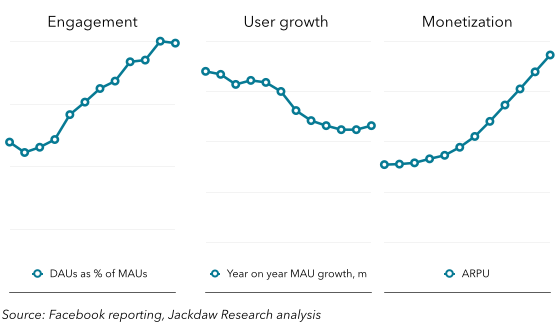
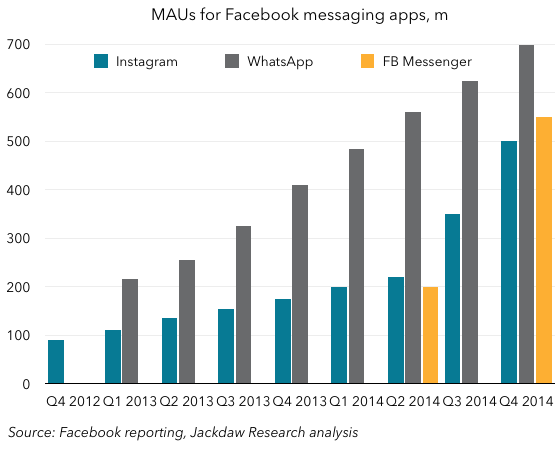

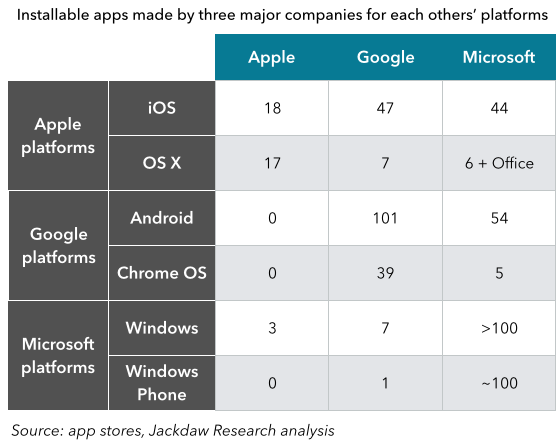
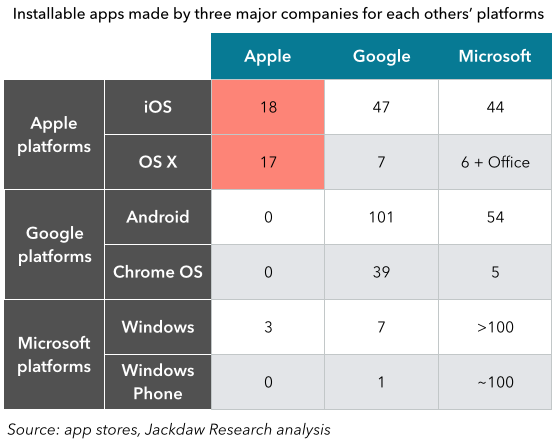 The key conclusion here is that Apple has focused very much on its own platforms, developing a little over a dozen apps for both iOS and OS X beyond those pre-installed on devices, but barely touching the other platforms at all. Where it does so, it’s exclusively to support major Apple services for iPhone and iPad users who also use Windows: iCloud Drive and iTunes are two of the three apps, while QuickTime – necessary for playing Apple-generated video files – is the third. Development of Safari on Windows – arguably a departure from Apple’s usual rules for a time – has been discontinued. It’s also worth noting that, even on its own platforms, Apple isn’t developing dozens of apps – there’s a small, focused number, which reflects another key Apple principle: keeping things simple, and focusing on what it does best.
The key conclusion here is that Apple has focused very much on its own platforms, developing a little over a dozen apps for both iOS and OS X beyond those pre-installed on devices, but barely touching the other platforms at all. Where it does so, it’s exclusively to support major Apple services for iPhone and iPad users who also use Windows: iCloud Drive and iTunes are two of the three apps, while QuickTime – necessary for playing Apple-generated video files – is the third. Development of Safari on Windows – arguably a departure from Apple’s usual rules for a time – has been discontinued. It’s also worth noting that, even on its own platforms, Apple isn’t developing dozens of apps – there’s a small, focused number, which reflects another key Apple principle: keeping things simple, and focusing on what it does best.